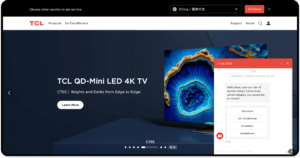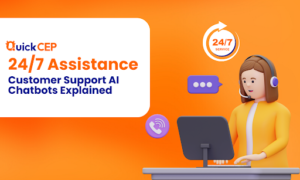Key Advantages of Retail Chatbots
Streamlined Operations
Using retail chatbots can help you perform business operations with improved efficiency. Chatbots can perform repetitive workflows and handle multitasking faster and more accurately than human staff. Here’s an example. QuickCEP’s retail chatbot can track orders swiftly by referring to the customer’s order ID. The customer can get a faster, real-time update compared to manually checking the store’s website.
Accurate Demand Forecasting
Chatbots can harness complex algorithms to forecast customer demand based on your current and previous sales records. The chatbot can estimate demand for a particular month or year by analyzing past trends and seasonalities in your sales performance.Improved Customer Experience
Retail chatbots are trained using a store’s knowledge base and help documents. This enables them to assist customers in their inquiries or concerns. If a customer is clueless about how to ask for a refund, they can simply ask the chatbot for help. In a heartbeat, the chatbot provides a thorough guide for the customer.Efficient Fraud Detection and Prevention
Many retail chatbots are trained with fraud detection capabilities enabling them to flag suspicious activities, inconsistencies, and anomalies. For instance, the chatbot can ask a customer about the legitimacy of their recent transaction for verification.Types of Retail Chatbots
1. Rule-based Chatbots
These are your old-school chatbots that respond to inquiries using predefined scripts, conversation rules, or decision trees. While they are reliable for 24/7 support, rule-based chatbots cannot understand conversation context. So, their engagement to customers is static with no room for personalized experience.2. AI-driven Retail Chatbots
Using artificial intelligence, retail chatbots can engage in a “personalized” level to customers. They use natural language processing (NLP) and machine learning to engage in human-like conversations and handle complex customer inquiries. Moreover, most AI chatbots can be developed with no coding by simply feeding it with training documents.3. Virtual Shopping Assistant
A virtual shopping assistant is like a physical store assistant that helps you when you buy something. But instead of being a human and working in a physical store, a virtual shopping assistant is a chatbot that assists customers in their sales journey. For example, the virtual assistant can suggest products tailored to your interests or process your refund request.4. Social Media Bots
Many retail stores use social media platforms for marketing and connecting with their current customers. A social media bot can efficiently handle inquiries, conversations, and requests that the store receives via social media. These bots are commonly deployed on Facebook, Instagram, X (Twitter), and TikTok.5.Examples of Retail Chatbots in Action
Let’s take a look at how exactly retail chatbots perform crucial business workflows, especially in customer service. Customer Support A customer asks the chatbot about a particular product that the store offers. AI helps in customer support by detailing the features and price of the product. If the customer has any follow-up questions, the chatbot responds automatically like a human store assistant.
Order Tracking
The customer wonders when they’ll receive their ordered product. Providing the chatbot with their order ID, they obtained an accurate and real-time status of the shipping. If there’s any delay, the chatbot can reassure the customer that the package will still arrive at the recipient.
Product Recommendations
A customer is looking for a certain type of clothing for an important event. The chatbot understands the needs and preferences of the customer. So, it will suggest some products that the customer might like.

Loyalty Program
A customer made a great deal of purchases in this retail store and earned sufficient points to qualify for the loyalty program. The retail chatbot enumerates some of the perks that the customer can avail of.

Feedback Collection
Upon successful interaction between the retail chatbot and a customer, the chatbot asks for the customer’s feedback regarding the store’s customer service. Collected feedback serves as a guide for improving the store’s service in the future.
Best Practices for Retail Chatbots
- Addressing customer inquiries
- Generating leads
- Assisting customers in their sales journey
- Providing product recommendations
Start simple chatbots
Start by training your chatbots with the “basics” of your business like its operating schedule, product lists, guidelines, etc. This will enable the chatbot to address basic customer inquiries. Over time, you can add more data sources with complex information to improve the chatbot’s performance. The simple chatbot below is trained only using the store’s internal help docs. But look closely at how it effectively handles the question.Use natural language processing (NLP)
Instead of using traditional codes or scripts, it’s better to train your chatbot using natural language processing (NLP). This makes your chatbot “conversational” or capable of responding to customer’s input in a human-like manner.Personalized recommendations
71% of customers are now expecting a personalized experience when transacting with businesses. For maximum customer satisfaction, you can use an AI retail chatbot to provide personalized recommendations. AI can give relevant product suggestions by analyzing customers’ previous transactions and interactions with the store.How To Create a Retail Chatbot Using QuickCEP’s Flow Bot

With QuickCEP, you can easily create a no-code retail chatbot that performs a particular task in automation.
In your account dashboard, select Bots. Then click on the Flow Templates tab. Afterward, pick a bot template according to your needs.
For instance, you can pick the Popular product (combination) recommendation template. This chatbot can provide relevant bestseller products to customers when they land on a specific product page. So, the chatbot is not only highlighting your popular products to customers but also tailoring their suggestions according to their interests.
You’re free to edit the nodes of the template you have chosen to customize the conversation flow between the bot and the customer.



